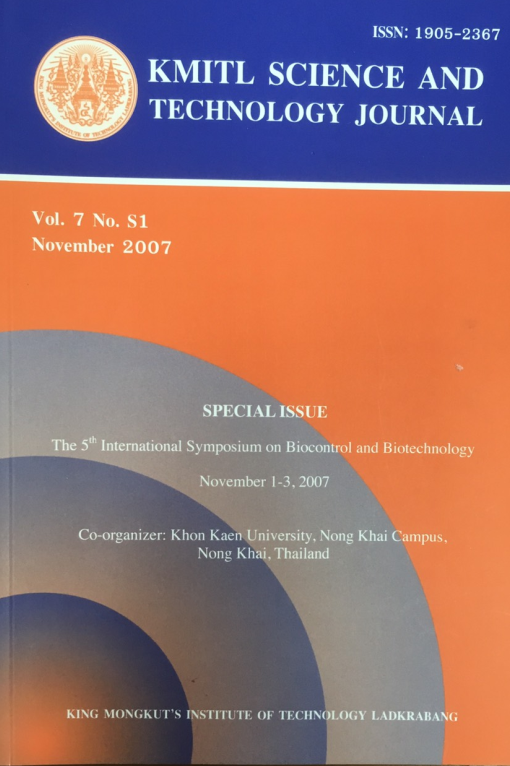EFFECT OF ENTOMOPATHOGENIC FUNGI, Beauveria bassiana (BALSAM) AND Metarhizium anisopliae (METSCH) ON NON TARGET INSECTS
Main Article Content
Abstract
The effect of entomopathogenic fungi, Beauveria bassiana (Balsamo) (isolate Bb.5335) and Metarhizium anisopliae (Metsch) (isolate Ma.7965) on non target insects, such as natural enemies, Coccinella septempunctata L. (Col., Coccinellidae), Chrysoperla carnea (Stephens) (Neur., Chrysopidae) and Dicyphus tamaninii Wagner (Him., Miridae) as well as beneficial soil insect, Heteromurus nitidus Templeton (Collembola: Entomobryidae) were studied. The experiments were conducted on conidial suspensions at a concentration of 1×108 conidia/ml. The 1st larval instars of C. septempunctata, C. carnea and adults of D. tamaninii and H. nitidus were tested. Mortality was recorded daily till the next generation.The results showed that B. bassiana was found to be non-pathogenic to natural enemies and beneficial soil insect. While M. anisopliae had pathogenicity to natural enemies, C. carnea and D. tamaninii, in which D. tamaninii was more susceptible than C. carnea with corrected mortalities of 10 and 4%, respectively.
Keywords: entomopathogenic fungi, side effect, non target insect
Corresponding author: E-mail: mthungrabeab@yahoo.com
Article Details
Copyright Transfer Statement
The copyright of this article is transferred to Current Applied Science and Technology journal with effect if and when the article is accepted for publication. The copyright transfer covers the exclusive right to reproduce and distribute the article, including reprints, translations, photographic reproductions, electronic form (offline, online) or any other reproductions of similar nature.
The author warrants that this contribution is original and that he/she has full power to make this grant. The author signs for and accepts responsibility for releasing this material on behalf of any and all co-authors.
Here is the link for download: Copyright transfer form.pdf
References
[2] Goettel, M.S., Poprawski, T.J., Vandenberg, J.D., Li, Z. and Roberts, D.W. 1990 Safety to Non-target Invertebrates of Fungal Biocontrol Agents. In: Lard, M., Lacey, L.A. and Davidson, E.W., Eds. Safety of Microbial Insecticides. CRC Press, pp. 209-231.
[3] Upadhyay, R.K. 2003 Advances in Microbial Control of Insect Pests. Kluwer Academic/ Plenum Publishers.
[4] Thungrabeab, M. and Aemprapa, S. 2002 Screening of Entomopathogenic Fungi Beauveriae. Spp. against the Aphid, Myzus persicae and Macrosiphum euphorbiae. Proceeding 3rd International Conference on Biopesticides, Kuala Lumpur, Malaysia, pp. 157-160.
[5] Sengonca, C., Thungrabeab, M. and Blaeser, P. 2006 Potential of The Different Isolates of Entomopathogenic Fungi from Thailand as Biological Control Agents against Western Flower Thrips, Frankliniella occidentalis (Pergande) (Thys., Thripidae), Journal of Plant Disease and Protection, 113(2), 74-80.
[6] Thungrabeab, M., Blaeser, P. and Sengonca, C., 2006. Possibilities for Biocontrol of The Onion Thrips Thrips tabaci Lindeman (Thys., Thripidae) Using Different Entomopathogenic Fungi from Thailand, Mitteilungen der Deutschen Gesellschaft Für allgemeine und Angewandte Entomologie, 15, 299-304.
[7] Thungrabeab, M., Blaeser, P. and Sengonca, C., 2006 Effect of Temperature and Host Plant on Efficacy of Different Entomopathogenic Fungi from Thailand Used against Frankliniella occidentalis (Pergande) (Thys., Thripidae) and Thrips tabaci Lindeman (Thys., Thripidae) in the Laboratory, Journal of Plant Diseases and Protection, 113(4), 181-187.
[8] Zimmermann, G. 1993 The Entomopathogenic Fungus Metarhizium anisopliae and Its Potential as a Biocontrol Agent, Pesticide Science, 37, 375-379.
[9] Gomez, K.A. and Gomez, A.A. 1984 Statistical Procedures for Agricultural Research. 2nd Edition. John Wiley and Sons Inc.
[10] Abbbott, W.S. 1925 A Method of Computing the Effectiveness of an Insecticide, Journal of Economic Entomology, 18, 265-267.
[11] SAS Institute. 2002 SAS/STAT User’s Guide. Version 9.1. Cary, NC.
[12] Broza, M., Pereira, P.M. and Stimac, J.L. 2001 The Non-susceptibility of Soil Collembola to Insect Pathogens and Their Potential as Scavengers of Microbial Pesticides, Pedobiologia, 45, 523-534.
[13] Dromph, M.K. and Vestergaard, S. 2002 Pathogenicity and Attractiveness of Entomopathogenic Hyphomycetes Fungi to Collembolans, Applied Soil Ecology, 21, 197-210.
[14] James, R.R. and Lighthart, B. 1994 Susceptibility of the Convergent Lady Beetle (Col., Coccinellidae) to Four Entomogenous Fungi, Environmental Entomology, 23, 190-192.
[15] Poprawski, T.J., Crisostomo, L.J. and Parker, P.E. 1998 Influence of Entomopathogenic Fungi on Serangium parcesetosum (Col., Coccinellidae), an Important Predator of Whiteflies (Hom., Aleyrodidae), Environmental Entomology, 27, 785-795.
[16] Magalhães, B.P., Lord, J.C., Wraight, S.P., Daoust, R.A. and Roberts, D.W. 1988 Pathogenicity of Beauveria bassiana and Zoophthor aradicans to The Coccinellid Predators Coleomegilla maculata and Eriopsis connexa, Journal of Invertebrate Pathology, 52, 471-473.
[17] Todorova, S.I., Cote, J.C., Martel, P. and Coderre, D. 1994 Heterogenecity of Two Beauveria bassiana Strains Revealed by Biochemical Tests, Protein Profiles and Bioassays on Leptinotarsa decemlineata (Col., Chrysomelidae) and Leomegilla maculate lengi (Col., Coccinellidae) Larvae, Entomophaga, 39, 159-169.


